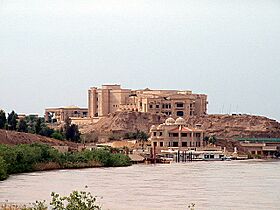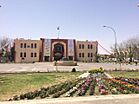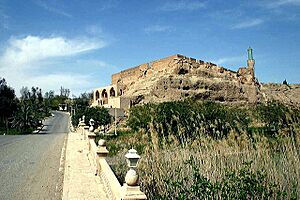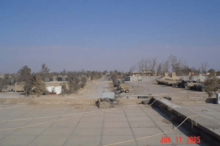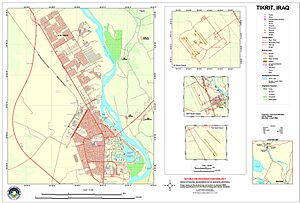Tikrit facts for kids
Quick facts for kids
Tikrit
تِكْرِيت
|
|
|---|---|
|
City
|
|
| Country | |
| Governorate | Saladin |
| Elevation | 137 m (449 ft) |
| Population
(2012)
|
|
| • Total | 160,000 |
|
|
|
Tikrit (Arabic: تِكْرِيت, romanized: Tikrīt) is a city in Iraq. It is located about 140 kilometers (87 miles) northwest of Baghdad. The city sits on the famous Tigris River. Tikrit is the main city of the Saladin Governorate. In 2012, about 160,000 people lived there.
Tikrit was once an old fort during the Assyrian Empire. It is famous for being the birthplace of the great Muslim military leader Saladin. Later, Saddam Hussein, a former leader of Iraq, was also born near Tikrit. Many important people from the Tikrit area held government jobs during Saddam Hussein's time. After 2003, the city saw some fighting. However, the Iraqi government took back control in 2015. Since then, the city has been peaceful.
Contents
History of Tikrit
Ancient Times to the Hellenistic Period
Tikrit was first mentioned as a fort along the Tigris River. This was around 615 BC. It was a safe place for the Babylonian king Nabopolassar. He was attacking the city of Assur at the time.
Later, during the Hellenistic period, Tikrit was known as Birtha.
Christian History in Tikrit
For many centuries, Tikrit was an important center for Christians. A Christian leader named Ahudemmeh became its first bishop in 559. Under another leader, Marutha of Tikrit, the church in Tikrit became even more important. Its influence reached as far as Central Asia.
The city remained a strong Christian center even after Islam arrived. It was known for its Christian literature. Famous Christians from Tikrit included Quriaqos of Tagrit, who became a patriarch (a high-ranking church leader).
Over time, Christians began to move north from Tikrit. This was because some Muslim governors made life difficult for them. Many settled in Mosul and other villages. In 1089, a governor ordered the main cathedral, known as the "Green Church," to be destroyed. While it was later rebuilt, many Christians had already moved away. By the 17th century, there were no Christians left in Tikrit.
From Byzantine to Ottoman Rule
The city was home to the Arab Christian tribe of Iyad. In 640, Muslims took control of Tikrit. From then on, it was part of the Jazira province. Later, Arab geographers considered it part of Iraq.
The Uqaylid dynasty of Arabs took control of Tikrit in 1036.
A very famous leader, Saladin, was born in Tikrit around 1138. The province where Tikrit is located today is named after him.
In 1393, the city was badly damaged by Timur. During the time of the Ottoman Empire, Tikrit was a small town. Its population was never more than 4,000 to 5,000 people.
Tikrit in the 20th Century
In September 1917, British forces captured Tikrit. This happened during World War I as they fought against the Ottoman Empire.
Tikrit is the birthplace of Saddam Hussein. He was the leader of Iraq for many years. Many important people in his government came from his family's tribe, the Al-Bu Nasir. Saddam trusted his relatives and family friends the most. Because of this, many key supporters had the same last name, al-Tikriti. Saddam even removed the use of last names in Iraq in 1977 to hide this fact. After he was captured and executed, Saddam Hussein was buried near Tikrit in his hometown of Al-Awja.
The Iraq War and After (2003-2015)
In 2003, the US-led forces invaded Iraq. Many thought Tikrit would be Saddam's last stand. The city was bombed heavily. On April 13, 2003, US Marines entered the city with little resistance. After Tikrit fell, US Army Major General Stanley McChrystal said that the main fighting was likely over.
However, during the time that followed, Tikrit became a place where resistance attacks happened. It was part of the "Sunni Triangle," where fighting was very strong. In June 2003, Abid Hamid Mahmud, a top aide to Saddam Hussein, was captured in Tikrit.
Saddam Hussein himself was hiding in and around Tikrit after Baghdad fell. He was hidden by relatives for about six months. He was finally captured on December 13, 2003, during Operation Red Dawn.
In 2005, the US military handed over Saddam Hussein's main palace complex in Tikrit to the Iraqi government. This complex had been used as a headquarters by US forces. The palace complex included Saddam's own palace, one for his mother, and a man-made lake. The Iraqi government planned to turn it into a resort. However, much of the palace was damaged and its contents were stolen.
The US Army also worked with the local government to improve the economy. They planned to build a school to teach people job skills. This school would help people learn about technology, construction, and repairs. It even had a textile mill where graduates could work.
In April 2010, two important leaders of a terrorist group were killed near Tikrit.
ISIL Insurgence (2011-2015)
On March 29, 2011, a group called the Islamic State of Iraq attacked Tikrit. This attack killed 65 people and injured over 100.
On June 11, 2014, the Islamic State of Iraq and the Levant (ISIL) took control of Tikrit. The Iraqi Army tried to take it back, leading to heavy fighting. The next day, ISIL carried out a terrible massacre. They killed at least 1,566 Iraqi Air Force cadets at Camp Speicher near Tikrit. The Iraqi government blamed ISIL and other groups for this crime. By July 2014, government forces had left Tikrit.
In September 2014, ISIL militants destroyed the historic Assyrian Church in Tikrit. This church dated back to 700 AD. They also blew up the historic Al-Arba'een Mosque.
In March 2015, the Iraqi Army and other forces launched a big operation to retake Tikrit. On March 31, the Iraqi government announced that the city had been recaptured from ISIL.
Famous People from Tikrit
- Saladin (1137 – 1193): He was a great military leader. He founded the Ayyubid dynasty.
- Saddam Hussein (1937 – 2006): He was the leader of Iraq from 1979 to 2003.
- Barzan al-Tikriti (1951 – 2007): He was one of Saddam Hussein's half-brothers. He was a leader in the Iraqi intelligence service.
- Ali Hassan al Majid (1941 – 2010): He was an Iraqi politician and military commander. He served as Saddam's defense minister.
- Ahmed Hassan al-Bakr (1914 – 1982): He was an Iraqi politician. He served as the president of Iraq from 1968 to 1979.
Geography and Climate
Tikrit is about 160 kilometers (100 miles) north of Baghdad. It is located on the Tigris River.
The city is built on rolling hills. It has branches and valleys that lead down to the Tigris River. The height of the land ranges from 45 to 50 meters (148 to 164 feet).
Tikrit's Climate
Tikrit has a hot desert climate. This means it is very hot and dry.
| Climate data for Tikrit, Iraq | |||||||||||||
|---|---|---|---|---|---|---|---|---|---|---|---|---|---|
| Month | Jan | Feb | Mar | Apr | May | Jun | Jul | Aug | Sep | Oct | Nov | Dec | Year |
| Mean daily maximum °C (°F) | 14.5 (58.1) |
17.4 (63.3) |
23.1 (73.6) |
29.0 (84.2) |
35.5 (95.9) |
40.9 (105.6) |
43.7 (110.7) |
43.7 (110.7) |
39.1 (102.4) |
32.3 (90.1) |
22.0 (71.6) |
16.1 (61.0) |
29.8 (85.6) |
| Daily mean °C (°F) | 9.1 (48.4) |
11.6 (52.9) |
16.8 (62.2) |
22.7 (72.9) |
29.2 (84.6) |
34.4 (93.9) |
37.2 (99.0) |
37.1 (98.8) |
32.3 (90.1) |
25.9 (78.6) |
16.1 (61.0) |
10.7 (51.3) |
23.6 (74.5) |
| Mean daily minimum °C (°F) | 4.2 (39.6) |
5.8 (42.4) |
9.9 (49.8) |
15.2 (59.4) |
21.5 (70.7) |
26.9 (80.4) |
29.8 (85.6) |
29.6 (85.3) |
24.9 (76.8) |
19.2 (66.6) |
10.6 (51.1) |
6.0 (42.8) |
17.0 (62.5) |
| Average precipitation mm (inches) | 35 (1.4) |
31 (1.2) |
30 (1.2) |
19 (0.7) |
5 (0.2) |
0 (0) |
0 (0) |
0 (0) |
0 (0) |
11 (0.4) |
25 (1.0) |
33 (1.3) |
189 (7.4) |
| Average relative humidity (%) | 68 | 57 | 38 | 29 | 20 | 14 | 15 | 16 | 19 | 27 | 47 | 63 | 34 |
| Source 1: Climate-Data.org (altitude: 109m) | |||||||||||||
| Source 2: SunMap | |||||||||||||
Culture and Community
The Tikrit Museum was damaged during the 2003 Iraq War.
The University of Tikrit was started in 1987. It is one of the largest universities in Iraq.
Tikrit Stadium is a sports field used mostly for soccer games. It is the home stadium for the Salah ad Din FC team. It can hold 10,000 people. A new, larger stadium is also being built in Tikrit. It will meet FIFA standards and hold 30,000 people.
Military and Transportation
The Iraqi Air Force has several air bases near Tikrit. These include Tikrit South Air Base, Tikrit East Air Base, and Al Sahra Airfield (also known as Camp Speicher).
Tikrit also has two small airports: Tikrit East Airport and Tikrit South Airport.
Images for kids
See also
 In Spanish: Tikrit para niños
In Spanish: Tikrit para niños


